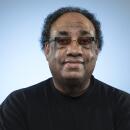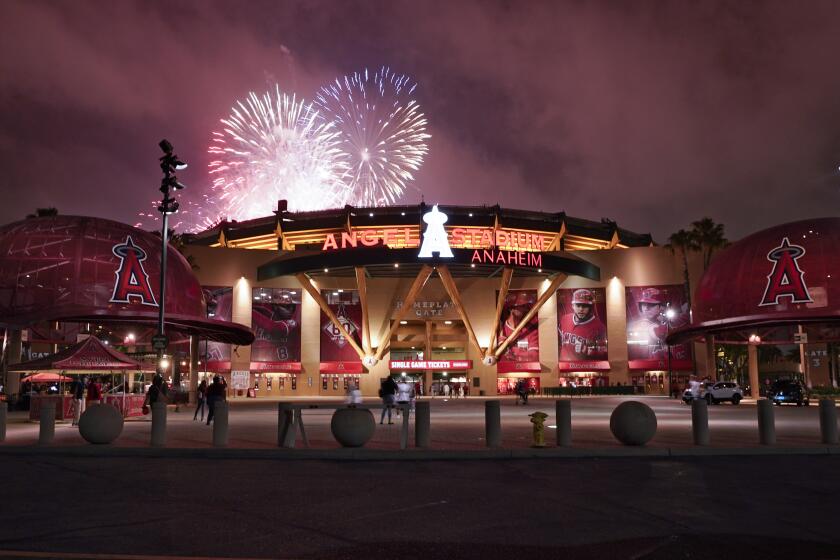Spats marring love affair with celebrity
- Share via
The melee last month between fans and players at the Indiana Pacers-Detroit Pistons game hasn’t yet inspired arena owners to remix Queen’s anthem “We Are the Champions” with revamped lyrics such as “We are the cheering, my friends, and we’ll keep on fighting to the end.”
But almost two weeks after the fists hit the fans, the debate rages over the impact of not only the most violent incident in the history of the NBA, but one of the most tumultuous in the history of U.S. sports.
While most of the attention has centered on the ruckus’ significance in the sports world, observers of sports and pop culture contend the riot is emblematic of an evolving dilemma that has invaded not only athletics but Hollywood -- the gradually growing air of discontent between celebrities and fans.
No brawls between stars and autograph seekers or moviegoers have broken out. But a variety of elements ranging from astronomical movie star salaries to the relentless spotlighting of off-screen behavior by the entertainment media, from the tabloids to the Internet, has contributed to a love-hate dynamic between fans and stars that at times escalates to vicious heckling and even physical attacks, observers say.
The star-making machinery of the ‘50s and ‘60s used by publicists and studios to ensure that stars would be shown in the most positive, glamorous -- and superficial -- light has been overcome by a relentless onslaught of media scrutiny examining and analyzing every move of even relatively minor celebrities. The attitude of sports fans who feel that some athletes are spoiled and overpaid is reflected as well in the entertainment arena.
“You have to be blind not to see this weird roller coaster obsession with celebrities,” said Steve Edwards, currently anchor of Fox’s syndicated “Good Day Live” and a veteran entertainment and sports journalist. “The media and the public make such a huge deal out of stars and athletes that we get into a weird relationship with them where sometimes too much emotion is expressed.”
In addition to the chaos at the game in Auburn Hills, Mich., which led to the suspension of several players, including Pacer Ron Artest for the remainder of the season, the past few months have been marked by overt and subtle clashes between public figures and stars. Dodger outfielder Milton Bradley came close to attacking a fan who threw a plastic bottle at him at Dodger Stadium. Rapper Dr. Dre was punched at last month’s Vibe Awards by a man asking for an autograph, leading to a violent outbreak and a stabbing. Laker star Kobe Bryant was greeted with boos when he served as presenter at last month’s American Music Awards, which was seen as a reaction to his alleged role in the departure of Shaquille O’Neal from the Lakers, and criminal rape charges against him that were dropped. Singer Ashlee Simpson was blasted on her website with a flood of caustic e-mails about her appearance on “Saturday Night Live,” after which it was revealed that she had planned to lip-sync to a backing track.
James Bacon, a veteran show business columnist, said that today’s celebrities have feet of clay, making them vulnerable to criticism.
“These days, stars are getting so much money, and they’re getting so much exposure,” said Bacon, who writes a column for the community paper “Beverly Hills 213.” “There’s no mystery anymore. We know everything about them, and there is more to dislike. Stars aren’t loved, like they were in the day of Clark Gable, Marilyn [Monroe] and John Wayne. There’s not that old-fashioned adoration anymore. There aren’t any real stars that have emerged in a glamorous way like the old stars did.”
Robert Thompson, director of the Center for the Study of Popular Television at Syracuse University, said, “There’s a whole different relationship now between fans and stars than what used to exist. The accessibility factor is one thing -- in those days, there were just a few magazines around, movie star fan magazines, and stars were a lot more isolated. No matter how big they were, they were only in our faces when they were doing what we wanted to see them doing.
“Now the biggest celebrities are unavoidable. Paris Hilton will ingrain herself in your consciousness whether you like it or not. And this overexposure can breed a bit of contempt.”
Contempt has blossomed on the other side, too, especially as stars continue to lash out against paparazzi who pursue them wherever they go. The equation has also been upset by concerns over security and stalking that have prompted many celebrities to be more wary when approached by fans -- a behavior that can be interpreted as aloofness and elitism, said veteran publicist Stan Rosenfield.
“There are these people who disguise themselves as fans,” noted Rosenfield, who owns Stan Rosenfield & Associates. “They will stalk these stars, hang out outside their hotel, wait for an autograph, then sell it on Ebay. They’re not going home to put these autographs in a scrapbook. They know every move these stars make.”
Part of the growing friction is also due to the continual flaunting of material goods by celebrities, along with a sense of entitlement displayed by some stars. The memories of newsman Edward R. Murrow interviewing public figures and celebrities at home on his “Person to Person” CBS series in the 1950s and ‘60s seem quaint when compared with the shows on network and cable television that focus on stars’ lavish lifestyles, houses, cars and entourages. Reports of stars receiving tens of millions of dollars for projects are staples of “Access Hollywood” and power lists in magazines such as Entertainment Weekly.
“When the stars make as much money as they do, people don’t like to hear them whine,” Rosenfield said. “They make $20 million, but they seem put out because someone asked for an autograph.”
Prominent show business publicist David Brokaw said some celebrities have alienated fans by not putting enough energy into quality projects.
“These stars have to respect themselves and have a nice level of self-esteem,” said Brokaw, owner of the Brokaw Company. “If a star or celebrity pays attention to the details and is attentive to the work and the audience, then they create something of value which is then embraced by the audience. If they get distracted from the work, then that’s where the erosion sets in.”
Edwards has noticed the shift in sensibility in the star-fan equation for some time. When he hosted a sports talk radio show for KABC-AM during the 1990s, he used to call sports news “the toy box.” That moniker would be incorrect these days, when the personal news about athletes and celebrities has taken on so much importance.
“When I was a kid, Elvis Presley was the biggest thing going, and yet you never saw him on the news,” Edwards said. “You heard his music on the radio and you saw him on ‘Ed Sullivan.’ He wouldn’t show up on local news or Walter Cronkite -- his celebrity didn’t demand that kind of attention. That has so dramatically changed. Now there are whole segments devoted to Martha Stewart, and how Lindsay Lohan is doing. Celebrities now are on the main stage of culture.”
Jamie Masada, owner of the Laugh Factory clubs in West Hollywood and New York, has seen the love-hate equation develop from a different perspective.
“I really saw a change between the comedians and the audience after Sept. 11,” Masada said. “I don’t know what it was, but there were times when I saw that the audiences were more hostile toward the comedians. And the comics were more territorial, they had shorter fuses. It was like ‘We’re not going to take it any more.’ I just sensed an extra tenseness after 9/11.”
He recalled one incident in New York when a comedian challenged a customer who was not laughing at his routine. “The comic said, ‘Why you looking so uptight, man?’ and the guy said, “Because you’re not funny.’ And this comic just went off on him. I’ve never seen anything like it. I got scared and had to pull him off stage, tell him to calm down, it’s just about jokes. It’s gone the other way, too, where both sides just go after each other. I’ve never seen anything like it in the 25 years I’ve been doing this.”
Though a star-fan clash like the fight in Auburn Hills, Mich., is unlikely, Edwards said it’s not out of the question: “There’s just a lot less civility now, and civility isn’t rewarded. Society is like a huge Jerry Springer show, and when things get ratcheted up to a fever pitch, something bad will happen.”
More to Read
Go beyond the scoreboard
Get the latest on L.A.'s teams in the daily Sports Report newsletter.
You may occasionally receive promotional content from the Los Angeles Times.











